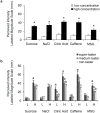Taste Perception of Sweet, Sour, Salty, Bitter, and Umami and Changes Due to l-Arginine Supplementation, as a Function of Genetic Ability to Taste 6-n-Propylthiouracil
- PMID: 28587069
- PMCID: PMC5490520
- DOI: 10.3390/nu9060541
Taste Perception of Sweet, Sour, Salty, Bitter, and Umami and Changes Due to l-Arginine Supplementation, as a Function of Genetic Ability to Taste 6-n-Propylthiouracil
Abstract
Behavioral reaction to different taste qualities affects nutritional status and health. 6-n-Propylthiouracil (PROP) tasting has been reported to be a marker of variation in taste perception, food preferences, and eating behavior, but results have been inconsistent. We showed that l-Arg can enhance the bitterness intensity of PROP, whilst others have demonstrated a suppression of the bitterness of quinine. Here, we analyze the taste perception of sweet, sour, salty, bitter, and umami and the modifications caused by l-Arg supplementation, as a function of PROP-taster status. Taste perception was assessed by testing the ability to recognize, and the responsiveness to, representative solutions of the five primary taste qualities, also when supplemented with l-Arg, in subjects classified as PROP-tasting. Super-tasters, who showed high papilla density, gave higher ratings to sucrose, citric acid, caffeine, and monosodium l-glutamate than non-tasters. l-Arg supplementation mainly modified sucrose perception, enhanced the umami taste, increased NaCl saltiness and caffeine bitterness only in tasters, and decreased citric acid sourness. Our findings confirm the role of PROP phenotype in the taste perception of sweet, sour, and bitter and show its role in umami. The results suggest that l-Arg could be used as a strategic tool to specifically modify taste responses related to eating behaviors.
Keywords: ">l-arginine; PROP taste status; taste perception.
Conflict of interest statement
The authors declare no conflict of interest.
Figures




Similar articles
-
Dose-Dependent Effects of L-Arginine on PROP Bitterness Intensity and Latency and Characteristics of the Chemical Interaction between PROP and L-Arginine.PLoS One. 2015 Jun 23;10(6):e0131104. doi: 10.1371/journal.pone.0131104. eCollection 2015. PLoS One. 2015. PMID: 26103639 Free PMC article.
-
Bitter, Sweet, Salty, Sour and Umami Taste Perception Decreases with Age: Sex-Specific Analysis, Modulation by Genetic Variants and Taste-Preference Associations in 18 to 80 Year-Old Subjects.Nutrients. 2018 Oct 18;10(10):1539. doi: 10.3390/nu10101539. Nutrients. 2018. PMID: 30340375 Free PMC article.
-
Effect of chemical interaction between oleic acid and L-Arginine on oral perception, as a function of polymorphisms of CD36 and OBPIIa and genetic ability to taste 6-n-propylthiouracil.PLoS One. 2018 Mar 22;13(3):e0194953. doi: 10.1371/journal.pone.0194953. eCollection 2018. PLoS One. 2018. PMID: 29566052 Free PMC article.
-
Genetic variation in taste sensitivity to 6-n-propylthiouracil and its relationship to taste perception and food selection.Ann N Y Acad Sci. 2009 Jul;1170:126-39. doi: 10.1111/j.1749-6632.2009.03916.x. Ann N Y Acad Sci. 2009. PMID: 19686122 Review.
-
Genetic variation in taste perception: does it have a role in healthy eating?Proc Nutr Soc. 2011 Feb;70(1):135-43. doi: 10.1017/S0029665110003976. Epub 2010 Nov 22. Proc Nutr Soc. 2011. PMID: 21092367 Review.
Cited by
-
Impact of Steam Processing on the Physicochemical Properties and Flavor Profile of Takifugu flavidus: A Comprehensive Quality Evaluation.Foods. 2025 Apr 27;14(9):1537. doi: 10.3390/foods14091537. Foods. 2025. PMID: 40361620 Free PMC article.
-
An automated method to detect and quantify fungiform papillae in the human tongue: Validation and relationship to phenotypical differences in taste perception.Physiol Behav. 2018 Feb 1;184:226-234. doi: 10.1016/j.physbeh.2017.12.003. Epub 2017 Dec 6. Physiol Behav. 2018. PMID: 29223711 Free PMC article.
-
Changes of Taste, Smell and Eating Behavior in Patients Undergoing Bariatric Surgery: Associations with PROP Phenotypes and Polymorphisms in the Odorant-Binding Protein OBPIIa and CD36 Receptor Genes.Nutrients. 2021 Jan 16;13(1):250. doi: 10.3390/nu13010250. Nutrients. 2021. PMID: 33467165 Free PMC article.
-
Differences in Salivary Proteins as a Function of PROP Taster Status and Gender in Normal Weight and Obese Subjects.Molecules. 2021 Apr 13;26(8):2244. doi: 10.3390/molecules26082244. Molecules. 2021. PMID: 33924512 Free PMC article. Clinical Trial.
-
Electrophysiological Responses from the Human Tongue to the Six Taste Qualities and Their Relationships with PROP Taster Status.Nutrients. 2020 Jul 7;12(7):2017. doi: 10.3390/nu12072017. Nutrients. 2020. PMID: 32645975 Free PMC article.
References
-
- Mattes R.D. Fat Taste in Humans: Is It a Primary? In: Montmayeur J.P., le Coutre J., editors. Fat Detection: Taste, Texture, and Post Ingestive Effects. CRC Press; Boca Raton, FL, USA: 2010. pp. 167–193.
MeSH terms
Substances
LinkOut - more resources
Full Text Sources
Other Literature Sources
Medical

